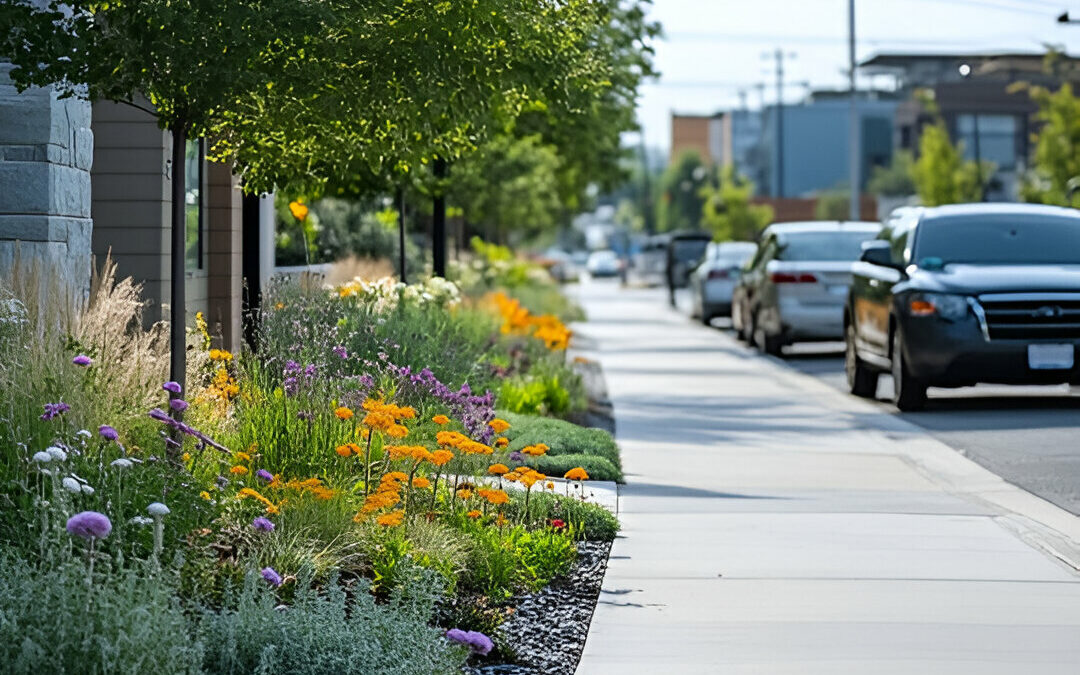Welcome to an in-depth look into an unexpected champion of environmental sustainability in Ann Arbor, Michigan – the humble concrete sidewalk.
These seemingly ordinary pathways are more than just thoroughfares to our daily destinations.
They are an integral part of the city’s environmentally-friendly initiatives, offering a multitude of benefits that often go unnoticed.
From their durability and recyclability to the way they help manage rainwater runoff, these sidewalks play a crucial role in maintaining the city’s commitment to a greener future.
So, let’s take a moment to appreciate and understand the environmental advantages of Ann Arbor’s concrete sidewalks as we continue our journey through the city.
The Sustainability of Concrete Sidewalks
While concrete might seem like a purely man-made material, it offers several sustainability advantages when used for sidewalks:
Durability and Longevity:
- Reduced Replacement Needs: Concrete is incredibly durable, resistant to wear and tear, and can withstand the elements for decades, even centuries.
- Minimized Resource Consumption: This longevity significantly reduces the need for frequent replacements, minimizing the consumption of resources like raw materials.
- Environmental Impact Offset: Although concrete production requires energy, its long lifespan helps offset this initial environmental cost.
Local Sourcing and Reduced Transportation:
- Minimized Carbon Footprint: Concrete is primarily made from locally sourced materials like sand, gravel, and cement.
- Reduced Transportation Needs: This minimizes the need for long-distance transportation of raw materials, significantly reducing fuel consumption and associated greenhouse gas emissions.
Versatility and Design Flexibility:
- Adaptable to Various Needs: Concrete can be easily molded and shaped into various forms.
Low Maintenance:
- Reduced Maintenance Needs: With proper construction and regular maintenance (such as crack sealing), concrete sidewalks require minimal upkeep.
By embracing sustainable concrete practices and prioritizing longevity, we can enhance the environmental performance of concrete sidewalks and contribute to more sustainable urban environments.
Concrete’s Role in Reducing Urban Heat
Urban heat islands are a significant environmental challenge, where urban areas experience significantly higher temperatures than surrounding rural areas.
Reflectivity and Reduced Heat Absorption:
- Albedo Effect: Concrete, particularly when pigmented with lighter colors, exhibits high albedo, meaning it reflects a significant portion of solar radiation.
- Reduced Heat Absorption: This reflectivity minimizes the amount of solar energy absorbed by the concrete surface.
- Contrast with Dark Surfaces: In contrast, dark-colored surfaces like asphalt absorb a large amount of solar radiation.
Cooler Microclimates:
- Reduced Heat Transfer: By reflecting sunlight, concrete sidewalks, and pavements help maintain cooler surface temperatures.
- Cooler Air Temperatures: This cooler surface temperature contributes to cooler air temperatures in the immediate vicinity.
Environmental Benefits:
- Reduced Energy Consumption: Cooler urban environments reduce the reliance on air conditioning.
- Lowered Greenhouse Gas Emissions: Reduced energy consumption for cooling translates to lower greenhouse gas emissions.
- Improved Air Quality: High temperatures exacerbate air pollution by increasing the formation of ground-level ozone and other harmful pollutants
- Enhanced Human Comfort: Cooler urban environments improve human comfort and well-being.
By strategically utilizing concrete and incorporating sustainable design principles, we can leverage this versatile material to mitigate the urban heat island effect and create more livable and sustainable urban environments.
Concrete Sidewalks in Ann Arbor, MI
You’re right, the concrete sidewalks in Ann Arbor are a testament to the city’s commitment to sustainability.
Here’s a more detailed look:
Local Sourcing and Reduced Environmental Impact:
- Minimized Transportation: Utilizing locally sourced materials like sand, gravel, and cement minimizes the environmental impact associated with long-distance transportation.
- Support for Local Economies: Sourcing materials locally also supports local businesses and contributes to the regional economy.
Durability and Longevity:
- Reduced Resource Consumption: Concrete sidewalks are designed to last for decades, even centuries, with proper maintenance.
- Reduced Environmental Impact of Construction: Frequent replacements involve repeated cycles of construction, each with its environmental impacts.
Stormwater Management:
- Permeable Concrete Options: While not always implemented, some sidewalks in Ann Arbor may utilize permeable concrete.
- Reduced Pollution Runoff: By allowing rainwater to infiltrate the ground, permeable concrete helps to filter out pollutants before they reach local waterways.
Pedestrian Safety and Accessibility:
- Well-Maintained Sidewalks: Well-maintained sidewalks provide a safe and accessible pedestrian pathway.
- Community Connectivity: Sidewalks enhance community connectivity by providing safe and convenient routes for pedestrians to access local businesses, parks, and other community destinations.
By embracing these principles, Ann Arbor demonstrates a commitment to sustainable urban development and sets an example for other communities seeking to create more environmentally friendly and livable urban spaces.
The humble concrete sidewalk in Ann Arbor, Michigan serves as a surprising champion of environmental sustainability.
From its durability and local sourcing to its role in managing urban heat and stormwater, the concrete sidewalk is more than just a path – it’s an intricate part of the city’s green initiatives.
By acknowledging and understanding these environmental advantages, we can appreciate the significance of such infrastructures in achieving sustainability goals and creating more livable urban spaces.
Ann Arbor’s commitment to these principles is a testament to the potential of urban environments to adapt and thrive in an environmentally conscious manner.


Recent Comments